Summary
Vibrio is a genus of bacteria that includes several species known to cause diseases in humans and other animals. These bacteria are typically found in marine environments and are shaped like curved rods. Some notable species include Vibrio cholerae, which causes cholera, and Vibrio parahaemolyticus, which can cause gastrointestinal illness. Vibrio infections are often associated with consuming contaminated seafood or exposure to contaminated water. Proper food handling and sanitation practices are essential for preventing Vibrio-related illnesses.
Some important Vibrio species include Vibrio cholerae, Vibrio parahaemolyticus, and Vibrio vulnificus.
Vibrio Cholerae
Staining and Microbiologic Features:
- Comma-shaped rods that exhibit gram-negative staining [1]
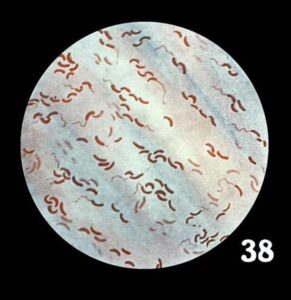
ff vibrio” by isis325 is licensed under CC BY 2.0.
- Facultative anaerobes that test positive for catalase [2]
- The polar flagellum of V. cholerae helps in its motility [1]
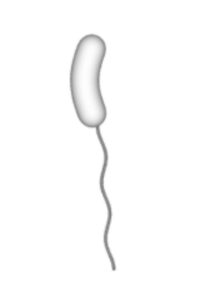
This work is adapted from “Vibrio diagram” by Y tambe is licensed under CC BY-SA 3.0.
- It is acid-sensitive and is susceptible to the acidic conditions of the stomach. Consequently, it requires a high infective dose to cause infection [3].
- It thrives in saline environments (halophilic) [4].
Virulence:
- V. cholerae does not invade intestinal epithelial cells. Clinical manifestation of the disease occurs when it attaches to intestinal epithelial cells and releases its toxin. Cholera toxin contains one A subunit and five B subunits. B subunit binds with the mucosal receptor (Ganglioside GM1) and facilitates entry of A-subunit into the host cell. The A subunit of cholera toxin boosts cAMP (cyclic adenosine monophosphate) levels by increasing adenylate cyclase activity. Elevated cAMP, in turn, triggers the secretion of sodium and chloride ions while inhibiting their reabsorption. This disruption in ion transport results in profuse, watery diarrhea [5].
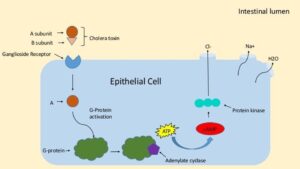
File:Cholera toxin.jpg” by Jessica Brochu is licensed under CC BY-SA 4.0.
- V. cholerae produces mucinase that breaks down mucus and facilitates its attachment to the epithelial cells [6].
- Vibrio cholerae produces neuraminidase, which alters the cell surface of target cells and enhances the availability of GM1 receptor sites for cholera toxin [7].
- Zonula occludens toxin produced by V. cholerae disrupts tight junctions between intestinal epithelial cells, resulting in increased fluid and electrolyte movement across the mucosal lining [7].
- Other important virulence factors include H-antigen, fimbriae, accessory cholera enterotoxin, and chemotaxis protein [6,7].
Transmission:
Diseases and Complications:
- Cholera: The patient can present with profuse, watery diarrhea (rice-water stools). Pus is absent in stools [9].
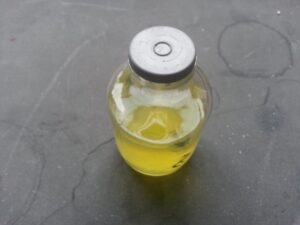
Cholera patient stool” by Ajay Kumar Chaurasiya is licensed under CC BY-SA 4.0.
- Depletion of fluids and electrolytes may result in potentially life-threatening complications such as hypovolemic shock, arrhythmias, and renal failure. This condition can be potentially life-threatening, and untreated patients have a high mortality rate [8].
Diagnostic Testing:
- Darkfield microscopy can also help in visualizing the organism [9]
- Culture on selective media such as thiosulfate citrate bile sucrose (TCBS) agar will show flat yellow colonies of Vibrio cholerae [9]
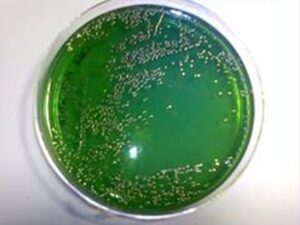
uu vibrio parahaemolyticus tcbs” by isis325 is licensed under CC BY 2.0.
- Immunoassays [10]
Vibrio Parahaemolyticus
- It is a gram-negative organism that thrives in saline environments (halophilic) [11]. It tests positive for oxidase [11], and its important virulence factors include H-antigen, capsule, and hemolytic cytotoxin [6,9]. It can grow on blood and TCBS agar [11].
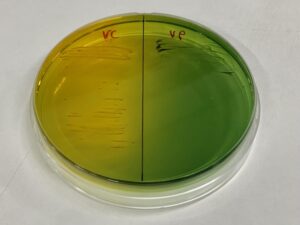
File:TCBS agar plate of Vibrio Cholerae and vibrio parahaemolyticus.jpg” by Chainwit. is licensed under CC BY-SA 4.0.
- Consumption of contaminated fish can result in V. parahaemolyticus infection, and the affected patient can present with nausea, vomiting, fever, and diarrhea. Some people who come in contact with contaminated seawater may also develop wound infections [12].
Vibrio Vulnificus:
- Vulnificus is also a gram-negative rod [3]. Its virulence factors include polysaccharide capsules, cytolysins, protease, and collagenase [7]. It can cause septicemia and severe wound infection. High-risk patients, particularly those with liver disease such as cirrhosis, may initially present with cellulitis that can rapidly advance to necrotizing fasciitis [1].
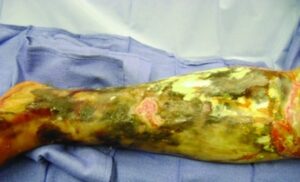
Necrotizing fasciitis caused by Vibrio Vulnificus” by Torrance HD, Cordova AC, Hoppe IC is licensed under CC BY 2.0.
It produces blue-green colonies on TCBS agar [11].
References:
1 Jawetz, Melnick, & Adelberg’s Medical Microbiology Twenty-Seventh Edition (page no: 252)
2 Medical Microbiology by Patrick R. Murray Ph.D., Ken Rosenthal Ph.D., Michael A. Pfaller MD, 8th edition (page no: 266)
3 First Aid for USMLE step 1, 2021 edition (page no: 146)
4 Jawetz, Melnick, & Adelberg’s Medical Microbiology Twenty-Seventh Edition (page no: 253)
5 CMMRS edition 6, 2016-17 (page no: 80)
6 CMMRS edition 6, 2016-17 (page no: 86)
7 Medical Microbiology by Patrick R. Murray Ph.D., Ken Rosenthal Ph.D., Michael A. Pfaller MD, 8th edition (page no: 267)
8 Medical Microbiology by Patrick R. Murray Ph.D., Ken Rosenthal Ph.D., Michael A. Pfaller MD, 8th edition (page no: 268)
9 CMMRS edition 6, 2016-17 (page no: 87)
10 Medical Microbiology by Patrick R. Murray Ph.D., Ken Rosenthal Ph.D., Michael A. Pfaller MD, 8th edition (page no: 270)
11 Jawetz, Melnick, & Adelberg’s Medical Microbiology Twenty-Seventh Edition (page no: 256)
12 Medical Microbiology by Patrick R. Murray Ph.D., Ken Rosenthal Ph.D., Michael A. Pfaller MD, 8th edition (page no: 269)

